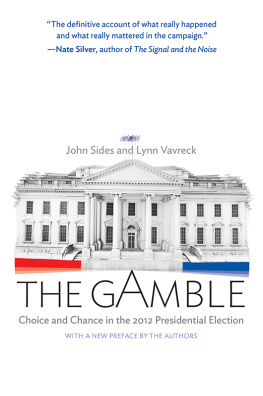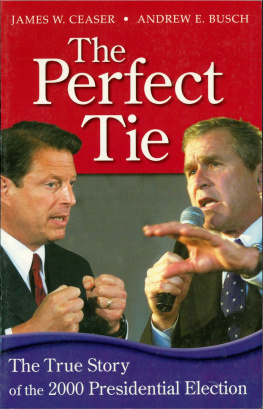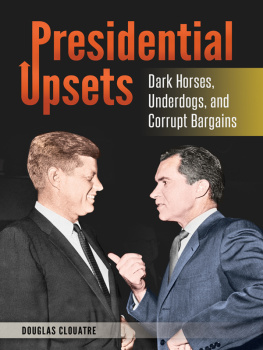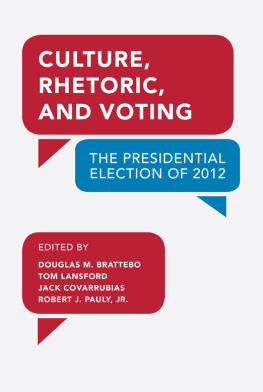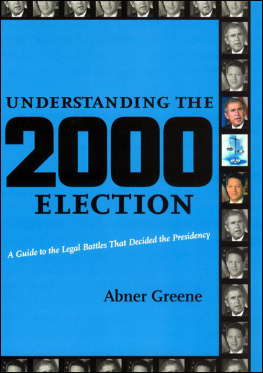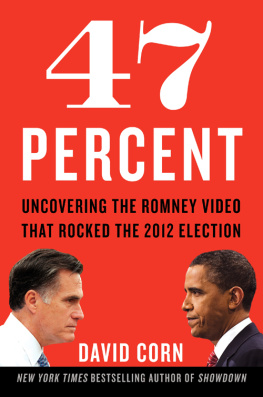
THE GAMBLE
John Sides and Lynn Vavreck
THE GAMBLE
Choice and Chance in the 2012 Presidential Election
PRINCETON UNIVERSITY PRESS
Princeton and Oxford
Copyright 2013 by Princeton University Press
Published by Princeton University Press, 41 William Street,
Princeton, New Jersey 08540
In the United Kingdom: Princeton University Press, 6 Oxford Street,
Woodstock, Oxfordshire OX20 1TW
press.princeton.edu
All Rights Reserved
ISBN 978-0-691-15688-0
Library of Congress Control Number: 2013942892
British Library Cataloging-in-Publication Data is available
This book has been composed in Minion and Ideal Sans
Printed on acid-free paper.
Printed in the United States of America
10 9 8 7 6 5 4 3 2 1
To Serena, Ethan, and Hannah, with gratitude and love.JMS
This ones for you, Larryfor professional inspiration and personal grounding. And for you, Jeff, for the opposite.LVL
CONTENTS
FIGURES AND TABLES
PREFACE TO THE PAPERBACK EDITION
The scientific study of presidential elections arguably dates back to a 1948 book called The Peoples Choice. Its authors, Paul Lazarsfeld, Bernard Berelson, and Hazel Gaudet, set out to understand the 1940 presidential race between President Franklin Roosevelt and Wendell Willkie in an unprecedented fashion. Setting up shop in Erie County, Ohio, they interviewed a sample of residents every month from May through November of the election year, thereby tracking the opinions of the same people interviewed at multiple points in time.
What they found was surprising to many. At a time when the rise of fascism and the development of mass mediaespecially radiohad raised fears about peoples susceptibility to propaganda, Lazarsfeld and colleagues found that peoples views of the candidates were mostly stable. Very few people switched their support from Roosevelt to Willkie, or vice versa. Campaign propaganda did not seem as powerful as many believed it would be.
But the campaign still mattered, just in more subtle ways. For one, it helped to reinforce the opinions people already had. If you were a Roosevelt supporter, the campaign solidified this choice. The campaign also pushed undecided voters to the candidate that they were already predisposed to support. Undecided voters whose demographic profile made them look like Democrats mostly ended up supporting Roosevelt, and those who looked like Republicans mostly ended up supporting Willkie. Lazarsfeld and colleagues showed that a campaign could be consequential, even in an electorate in which many voters were not up for grabs.
In the years after this book, other scholars began to use social science methods and data to study elections. Lazarsfeld would help author a second book, this one about the 1948 election. Not long afterward, a team of social scientists at the University of Michigan wrote other seminal books about voting behavior and electionsparticularly The American Voteras well as articles about individual presidential elections that were published not long after the elections themselves. More recently, there have been notable book-length studies of the tumultuous 2000 presidential election and the historic 2008 election, when the first African-American, Barack Obama, was elected president.
The Gamble fits squarely in this tradition. It is the story of how Republicans nominated Mitt Romney to challenge Barack Obama in 2012, and how Obama ultimately won reelection. We tell this story using similar kinds of tools as these earlier books, including quantitative data and statistical methods. Indeed, one of our central sources of data is a survey not unlike the one in Erie County, Ohio: multiple interviews with the same set of voters over the year before the election. The main difference is whereas that 1940 survey focused on 600 voters in one county, ours includes 45,000 voters across the United States. These tools help us to identify why voters decided as they did and how the campaign affected them along the way. This, in turn, helps explain why Obama won and what implications his reelection has for party competition in future elections.
There is a parallel tradition of campaign narratives written by journalists. In fact, perhaps the canonical book in this traditionTheodore Whites The Making of the Presidentwas published not long after the first social scientific accounts appeared, when White documented the 1960 election between Richard Nixon and John F. Kennedy. White would write other installments after the 1964, 1968, and 1972 presidential elections.
Journalists working in this tradition rely on different sources of information than do social scientists. Rather than crunch data, they spend many months on the campaign trail, following the candidates. They conduct interviews with the candidates, their campaign strategists, and sometimes a small number of voters. These books seek to answer a similar question about the electionwhy did the winner win?but mainly by focusing on the decisions the candidates made. These books thus paint vivid pictures of the characters in the campaigntheir personalities, their strengths and weaknesses, their foibles and eccentricities. These books dwell on dramatic moments. They tell lots of good stories. After the 2012 election, several such books were written, including Dan Balzs Collision 2012 and Mark Halperin and John Heilemanns Double Down: Game Change 2012.
The Gamble differs in key respects from these books. We lack the access to the candidates that journalists can negotiate; and thus we cannot ask the candidates why they did what they did. What we can do, however, is figure out whether their actions made an impact on voters. That is where those 45,000 voters, a few graphs, and the statistics waiting in the appendix become useful.
To take one example, consider a storyline being pushed by Romney after his loss. He blamed his loss on the fact that Obama had given gifts to key constituencies. For instance, Obamas signature achievement in his first term, health care reform, mandated insurance coverage of contraceptives. Romney argued that free contraceptives helped Obama woo female voters. In Double Down, Halperin and Heilemann report Romneys claim, but lacking any means of testing it and any countervailing data from the Obama campaign, they let the claim stand. By contrast, we use our survey data to examine how much the debate over reproductive rights affected voters. Contrary to Romneys claim, we found that the issue of reproductive rights did more to keep male voters from leaving Obama than it did to attract women to him. Most women for whom this issue was important had already chosen their candidate before the debate about contraception and the controversies that followed throughout 2012.
To be sure, both kinds of books about an election are valuable. It is important to understand what was going on inside campaign war rooms and what was going on inside the voting booth. Each traditionsocial science and journalismcan complement the other. When they diverge, however, we think that science should be privileged, to the extent that it rigorously tests competing claims using carefully collected data. Interestingly, this belief has become prevalent not only among scientists, but also among some journalists and a fair bit of the population. Hard data and scientific approaches increasingly animate the conversation within journalism, perhaps most visibly in outlets like Nate Silvers 538 website (which lived at the New York Times during 2012) and the wonkish blogging of Ezra Klein (in 2012 at the Washington Post). Campaigns are increasingly scientific themselvesgathering data, running experiments, and constructing statistical models to predict voter turnout and preferences for the candidates. Modern campaign strategy increasingly resembles what Sasha Issenberg provocatively called The Victory Lab in his book of the same title. There is every reason to think, then, that the understanding of campaigns and their effects will draw more and more on approaches similar to ours.
Next page
